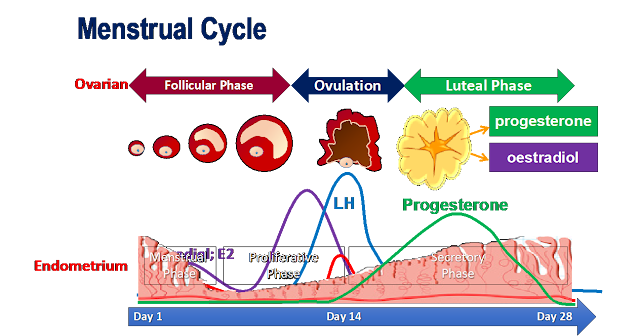INTRODUCTION: The menstrual cycle includes the activity of the hormones of the ovaries and anterior pituitary gland and the resultant changes in the ovaries that we sometimes call, the ovarian cycle. This then is preceded by changes in the uterus which we sometimes call the uterine cycle.
HORMONES INVOLVED IN THE PROCESS: Follicle Stimulating (FSH) and Luteinizing Hormone (LH) from the anterior pituitary gland, estrogen from the ovarian follicle, and progesterone from the corpus luteum are the four hormones involved. It is the fluctuation and production of these hormones that influence the ovulation cycle and and then menstruations.
THE CYCLE: A cycle may be described in terms of three phases: menstrual phase, follicular phase, and luteal phase.
1. Menstrual phase: The loss of the functional layer of the endometrium is called menstruation or the menses. Although this is actually the end of a menstrual cycle, the onset of menstruation is easily pinpointed and is, therefore, a useful starting point. Menstruation may last 2 to 8 days, with an average of 3 to 6 days. At this time, secretion of FSH is increasing, and several ovarian follicles begin to develop.
2. Follicular phase: FSH stimulates growth of ovarian follicles and secretion of estrogen by the follicle cells. The secretion of LH is also increasing, but more slowly. FSH and estrogen promote the growth and maturation of the ovum, and estrogen stimulates the growth of blood vessels in the endometrium to regenerate the functional layer. This phase ends with ovulation, when a sharp increase in LH causes rupture of a mature ovarian follicle.
3. Luteal phase: Under the influence of LH, the ruptured follicle becomes the corpus luteum and begins to secrete progesterone as well as estrogen. Progesterone stimulates further growth of blood vessels in the functional layer of the endometrium and promotes the storage of nutrients such as glycogen. As progesterone secretion increases, LH secretion decreases, and if the ovum is not fertilized, the secretion of progesterone also begins to decrease. Without progesterone, the endometrium cannot be maintained and begins to slough off in menstruation. FSH secretion begins to increase (as estrogen and progesterone decrease), and the cycle begins again.
OCCURANCE OF CYCLES: Women may have cycles of anywhere from 23 to 35 days, the normal range. Women who engage in strenuous exercise over prolonged periods of time may experience amenorrhea, that is, cessation of menses. This seems to be related to reduction of body fat. Apparently the reproductive cycle ceases if a woman does not have sufficient reserves of energy for herself and a developing fetus. The exact mechanism by which this happens is not completely understood at present. Amenorrhea may also accompany states of physical or emotional stress, anorexia nervosa, or various endocrine disorders.
RELATED;
1. INFERTILITY
2. DYSMENORRHEA














No comments:
Post a Comment